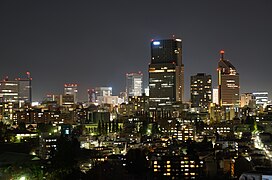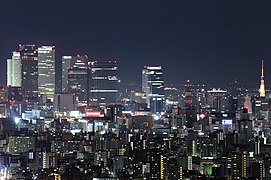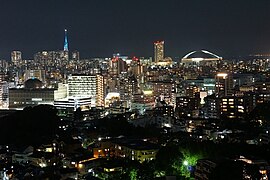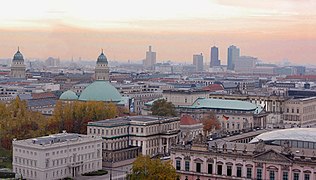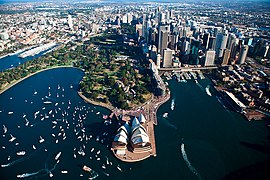Metropolis
An editor has nominated this article for deletion. You are welcome to participate in the deletion discussion, which will decide whether or not to retain it. |
This article needs additional citations for verification. (April 2021) |


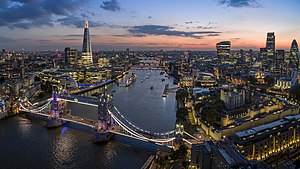
| Ekistics |
|---|
| Terms |
| Lists |
|
|
A metropolis (/mɪˈtrɒpəlɪs/ ⓘ)[2] is a large city or conurbation which is a significant economic, political, and cultural area for a country or region, and an important hub for regional or international connections, commerce, and communications.
A big city belonging to a larger urban agglomeration, but which is not the core of that agglomeration, is not generally considered a metropolis but a part of it. The plural of the word is metropolises,[3] although the Latin plural is metropoles, from the Greek metropoleis (μητρoπόλεις).
For urban areas outside metropolitan areas that generate a similar attraction on a smaller scale for their region, the concept of the regiopolis ("regio" for short) was introduced by urban and regional planning researchers in Germany in 2006.[4]
Etymology
[edit]Metropolis (μητρόπολις) is a Greek word, (plural: metropoleis) coming from μήτηρ, mḗtēr meaning "mother" and πόλις, pólis meaning "city" or "town", which is how the Greek colonies of antiquity referred to their original cities, with whom they retained cultic and political-cultural connections. The word was used in post-classical Latin for the chief city of a province, the seat of the government and, in particular, ecclesiastically for the seat or see of a metropolitan bishop to whom suffragan bishops were responsible.[5] This usage equates the province with the diocese or episcopal see.[6]
In a colonial context, it is the "mother city" of a colony, that is, the city which sent out settlers. The word has distant roots in the colonial past of Ancient Greece with first usage in Middle English around the 14th century.[7] This was later generalized to a city regarded as a center of a specified activity, or any large, important city in a nation.[citation needed]
Africa
[edit]Angola
[edit]Luanda is the capital and largest city in Angola. It is Angola's primary port, and its major industrial, cultural and urban centre. Its metropolitan area is the most populous Portuguese-speaking city in Africa, with over 8.3 million inhabitants.[8]
Democratic Republic of Congo
[edit]Kinshasa is a megacity with a population of about 15 million. Kinshasa is Africa's third-largest urban area after Cairo and Lagos.[9] It is projected to be one of the ten biggest cities in the world in 2050.[10]
Egypt
[edit]
Cairo[9] and Alexandria are considered Egypt's biggest metropolises.
Ethiopia
[edit]Addis Ababa is the capital city of Ethiopia, and where the African Union is headquartered. As of 2008 the metro population is approximately 4.5 million.[11]
Ghana
[edit]Accra is an economic and administrative hub, and serves as the anchor of the larger Greater Accra Metropolitan Area (GAMA).[12]
Ivory Coast
[edit]According to the 2014 census, Abidjan's population was 4.7 million, which is 20 percent of the overall population of the country, and this also makes it the sixth most populous city proper in Africa, after Lagos, Cairo, Kinshasa, Dar es Salaam, and Johannesburg. It has officially been designated as the "economic capital" of the country. In 2020 the Urban area population was over 5 million inhabitants.[13]
Kenya
[edit]Nairobi is the capital and the largest city of Kenya. The city proper had a population of 4,397,073 in the 2019 census, while the metropolitan area has a population of 9,354,580.[14]
Nigeria
[edit]Lagos is projected to be one of the ten biggest cities in the world in 2050.[9] As of 2015, unofficial figures put the population of "Greater Metropolitan Lagos", which includes Lagos and its surrounding metro area, extending as far as into Ogun State, at approximately 21 million.[15][16]
Tanzania
[edit]With a population increase of 5.6 percent per year from 2002 to 2012, Dar es Salaam is the third-fastest-growing city in Africa, after Bamako and Lagos, and the ninth-fastest-growing in the world. The metro population is expected to reach 15.12 million by 2020.[17][18]
South Africa
[edit]The largest city in South Africa is its economic hub of Johannesburg which has an estimated metro population of 5 635 127 in 2019, followed by the Cape Town metropolis (City of Cape Town) with an estimated metro population of 4 488 546 and the Durban metropolis (eThekwini) with an estimated metro population of 3 145 000.[19][20] Smaller metropolises within South Africa include Pretoria (City of Tshwane), East Rand (City of Ekurhuleni), Gqeberha (Nelson Mandela Bay), East London (Buffalo City) and Bloemfontein (Mangaung).
Uganda
[edit]Kampala is the capital and largest city of Uganda. Kampala's metropolitan area is estimated at 6,709,900 people in 2019 by the Uganda Bureau of Statistics[21] in an area of 8,451.9 square kilometres (3,263.3 sq mi). Kampala is reported to be among the fastest-growing cities in Africa, with an annual population growth rate of 4.03 percent.[22]
Asia
[edit]Afghanistan
[edit]The capital city, Kabul, has grown to become the country's sole metropolis, and is the only city in Afghanistan with more than one million people.[23]
Bangladesh
[edit]
In the People's Republic of Bangladesh, there are eleven metropolitan areas: Dhaka, Chittagong, Rajshahi, Rangpur, Sylhet, Khulna, Mymensingh, Cumilla, Barisal, Gazipur and Narayanganj.[24] Lands are highly priced and residents are considered to have a better urban lifestyle. Special police departments are allotted for the metropolitan cities, and there are city corporations for which mayors are elected for five-year regimes. Most of these cities have population density of 35,000/square mile or more. Dhaka is the wealthiest city out of all and is considered a megacity because its population surpassed 10 million.[25]
China
[edit]
China (People's Republic of China) is the fourth-largest country by geographical area and the second most populous country with over 1.4 billion people and is also known for its large number of metropolises, with recognised "tiers" that classify mainland metropolises. Nationally, the largest metropolises include Beijing, Shanghai, Guangzhou and Shenzhen, the four cities are classified as the "First-Tier Cities" (一线城市). Second-tier cities are numerous and consist of regional centres, such as Changsha, Chengdu, Chongqing, Hangzhou, Jinan, Nanjing, Qingdao, Shenyang, Tianjin, Wuhan, and Xi'an, etc.
Many of China's metropolises constitute a city cluster, such as the Yangtze River Delta Megalopolis and the Pearl River Delta Megalopolis.
India
[edit]India (Republic of India) is the seventh-largest country by geographical area and the most populous country with over 1.5 billion people. The 74th Amendment to the Indian Constitution defines a metropolitan area as an area having a population of 10 Lakh or 1 Million or more, comprised in one or more districts and consisting of two or more Municipalities or Panchayats or other contiguous areas, specified by the Governor by public notification to be a Metropolitan area. As of 2011 Census of India, India has 46 other cities with populations greater than one million.[26] Delhi, Mumbai, Kolkata, Chennai, Bangalore, Hyderabad, Pune, Ahmedabad, Kochi, are among the largest of 23 metropolitan cities in India.
-
Mumbai, the financial centre of India
-
New Delhi, federal capital of India
-
Kolkata, cultural and former capital of India
-
Chennai, the Automotive and healthcare of India
-
Bengaluru, the Silicon Valley and aviation capital of India
Indonesia
[edit]
In Indonesia, the metropolitan cities are in Jabodetabek (Jakarta, Bekasi, Bogor, Depok, and Tangerang), the biggest metropolitan area in Southeast Asia and the fifth biggest metropolitan area in the world (2007). The other metropolises are Bandung, Batam, Medan, Semarang, and Surabaya.
Iran
[edit]
In Iran, the metropolitan cities are in Greater Tehran and Greater Isfahan Metropolitan Area, and other cities such as Mashhad, Karaj, Shiraz, Tabriz, Qom, Ahvaz, Kermanshah and Rasht.
Japan
[edit]The Japanese legal term to (都) is by designation to be translated as "metropolis".[27] However, existing translations predate the designation[clarification needed]. Structured like a prefecture instead of a normal city, there is only one to in Japan, namely Tokyo. As of 2020[update], Japan has 12 other cities with populations greater than one million. The same Kanji character in Chinese, or in generic Japanese (traditional or non-specific), translates variously—city, municipality, special municipality—all qualify.
Malaysia
[edit]
In Malaysia, the capital Kuala Lumpur is the largest city, with a population of 7.8 million.[28] The other metropolises in Malaysia are Johor Bahru, Seremban, Malacca City, Shah Alam, Kuantan, Kuala Terengganu, Kota Bahru, Ipoh, Georgetown, Alor Setar, Kangar, Kota Kinabalu and Kuching.
Pakistan
[edit]According to the census of 2017, there are about 12 metropolitan areas in Pakistan each with a metro population of at least 2 million and city proper population of at least 0.5 million.[29][30][31] Karachi is the largest metropolitan area of Pakistan with a population of about 19.31 million, followed by Lahore (15.12 million), Faisalabad (9.873 million), Islamabad-Rawalpindi (8.412 million), Gujranwala (7.01 million), Multan (4.745 million), Peshawar (4.269 million), Sargodha (3.903 million), Sialkot (3.893 million), Bahawalpur (3.668 million), Quetta (2.275 million) and Hyderabad (2.199 million).[32]
Philippines
[edit]
The Philippines has three metropolises as defined by the National Economic and Development Authority. They are Manila, Cebu, and Davao.[33]
Metropolitan Manila, or Metro Manila, is the metropolitan region encompassing the city of Manila and its surrounding areas in the Philippines. It is composed of 16 cities and 1 municipality namely the city of Manila, Caloocan, Las Piñas, Makati, Malabon, Mandaluyong, Marikina, Muntinlupa, Navotas, Pasay, Pasig, Parañaque, Quezon City, San Juan, Taguig, Valenzuela and the municipality of Pateros. The region is the political, economic, social, cultural, and educational center of the Philippines. As proclaimed by Presidential Decree No. 940, Metro Manila as a whole is the Philippines' seat of government but the city of Manila is the capital. The largest city in the metropolis is Quezon City, while the largest business district is the Makati Central Business District.
Greater Manila Area is the contiguous urbanization region or Extended Metropolitan Manila surrounding Metro Manila. This built-up zone includes Metro Manila and the neighboring provinces of Bulacan to the north, Cavite and Laguna to the south, and Rizal to the east. Though sprawl continues to absorb new zones, some urban zones are independent clusters of settlements surrounded by non-urban areas.
Singapore
[edit]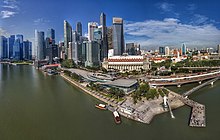
The Republic of Singapore is a sovereign island country and city-state located in maritime Southeast Asia. The country has no capital city.
South Korea
[edit]In the Republic of Korea there are seven special and metropolitan cities at autonomous administrative levels. These are the most populous metropolitan areas in the country. In decreasing order of the population of 2015 census, they are Seoul, Busan, Incheon, Daegu, Daejeon, Gwangju and Ulsan.
According to the census of 2015, cities of Changwon and Suwon also qualify for being elevated to the level of metropolitan cities (having population over 1 million), but any future plans to promote them into metropolitan city are unlikely to be accepted because of political concerns about the structure of administrative divisions. There are also some county-level cities with increasing population near 1 million, namely Goyang, Yongin, and Seongnam, but they are also unlikely to be promoted into metropolitan city because they are all satellite cities of Seoul.
Sri Lanka
[edit]The City of Colombo is the largest city in Sri Lanka. The Colombo Metropolitan Area is Sri Lanka's most urbanized region with a population of over 5 million people.[34][35][36][37]
Taiwan
[edit]Taipei City is the political, economic, and cultural centre of Taiwan. The Taipei–Keelung metropolitan area consists of 4 administrative divisions (Taipei, Keelung, New Taipei, and sometimes including Taoyuan) with a total of more than 9 million residents.[38] The metropolis houses the largest international airport in Taiwan and the 36th busiest airport in the world – Taiwan Taoyuan International Airport, which has an annual passenger traffic of nearly 50 million.[39]
United Arab Emirates
[edit]
There are 8 metropolises in the UAE: Dubai, Abu Dhabi, Sharjah, Al Ain, Ajman, Ras Al-Khaimah, Fujairah, and Umm Al-Quwain. Of these, Dubai is the largest.[40]
Kazakhstan
[edit]Almaty is Kazakhstan’s largest metropolitan area with over 2 million inhabitants. Other cities with population over a million include Astana, Shymkent.
Uzbekistan
[edit]Tashkent is Uzbekistan's most populous and largest city. Tashkent is the only city with over 3 million residents.Other largest cities are Samarkand, Bukhara and Fergana.
Europe
[edit]Austria
[edit]Vienna is the capital city of Austria, an old imperial city, and the seat of many international organisations, including OPEC, as well as hosting a main office of the United Nations. Together with its cultural acumen and history, these features make Vienna a true global metropolis, the only one in Austria.
Belgium
[edit]The region of Brussels contains the capital city of Belgium with a population of over 1.2 million people, it is the largest urban area in the Benelux. The region is the seat of the European Union, NATO and various other international institutions such as the World Customs Organization. It is nicknamed the 'Capital of Europe'.
Bosnia and Herzegovina
[edit]
Sarajevo is the capital and the largest city of Bosnia and Herzegovina, seat of the country's Presidency, government, parliament and the only metropolis in the country.[41]
Czech Republic
[edit]Prague is the Czech Republic's only metropolis, with more than 1.3 million people living within the city limits and with more than 2.6 million living in its metropolitan area. This makes the Prague metropolitan area one of largest in Europe.[42]
Denmark
[edit]In Denmark the only metropolis is the capital, Copenhagen, situated in the Capital Region of Denmark. It has more than 750,000 people living in city proper and 1.28 million in its urban area.[43]
Finland
[edit]Finland's capital, Helsinki, along with the neighboring areas (including Espoo, Kauniainen and Vantaa) forms a metropolitan area with an approximate population of 1.45 million people. This area is the only metropolis in the country.
France
[edit]A 2014 law allowed any group of communes to cooperate in a larger administrative division called a métropole. One métropole, Lyon, also has status as a department.
France's national statistics institute, Insee, designates 12 of the country's urban areas as metropolitan areas. Paris, Lyon and Marseille are the biggest, the other nine being Toulouse, Lille, Bordeaux, Nice, Nantes, Strasbourg, Rennes, Grenoble and Montpellier.[44]
Germany
[edit]The largest German city by administrative borders is Berlin, while Rhine-Ruhr is the largest metropolitan area (with more than 10 million people). The importance of a city is measured with three groups of indicators, also called metropolitan functions: The decision making and control function, the innovation and competition function, and the gateway function. These functions are seen as key domains for metropolitan regions in developing their performance.
In spatial planning, a metropolis is usually observed within its regional context, thus the focus is mainly set on the metropolitan regions. These regions can be mono central or multi central. Eleven metropolitan regions have been defined due to these indicators: Berlin-Brandenburg, Bremen-Oldenburg, Dresden-Halle-Leipzig, Frankfurt-Rhine-Main, Hamburg, Hannover-Braunschweig-Göttingen-Wolfsburg, Munich, Nuremberg, Rhine-Neckar, Rhine-Ruhr (with Cologne/Bonn), and Stuttgart.[45]
-
Berlin is Germany's largest city.
-
Rhine-Ruhr is Germany's largest metropolis (the photo shows Dortmund).
-
Frankfurt is one of Germany's most important cities.
-
Geographical position of the regiopolis Rostock.
Greece
[edit]Athens is the capital and largest city of Greece, with an urban population of over 4,000,000. It is also the 8th largest urban area in the European Union. Athens dominates the Attica peninsula and is one of the world's oldest cities, with a recorded history of over 3,400 years, and earliest human presence in the 11th millennium BC. Together with the port of Piraeus, one of Europe’s busiest passenger ports, Athens is one of the most important economic and cultural hubs in the Eastern Mediterranean and key trade route between Europe and the East. At the heart of the ancient city of Athens lies the world-famous Acropolis of Athens, a classical 5th C. BCE UNESCO World heritage site, built in honour of the Goddess Athena. At its heart lies the Parthenon, a masterpiece of classical architecture, built by architect Iktinoos (Ictinus) and sculptor Kallikratis (Callicrates) at the request of Pericles, at the height of the City’s power. Coined the Golden age of Athens, the Acropolis symbolises the culmination of Greek civilisation, that lay the foundations of empirical thinking in the arts, philosophy, theatre, music, mathematics, sciences and astronomy, and became the reference point of modern western civilisation. Today Athens receives more than 6.4 million visitors every year.
Hungary
[edit]Budapest has a population of 1,750,000, more than eight times the population of the second largest city, Debrecen.
Italy
[edit]As of January 1, 2015, there are 14 "metropolitan cities" in Italy. Rome, Milan, Naples and other big cores have taken in urban zones from their surrounding areas and merged them into the new entities, which have been home for one out of three Italians. The provinces remained in the parts of the country not belonging to any Città Metropolitana.[46]
Netherlands
[edit]The Randstad is in the Blue Banana and encompasses both the Amsterdam metropolitan area and Rotterdam–The Hague metropolitan area.
Poland
[edit]
The Union of Polish metropolises (Polish: Unia Metropolii Polskich), established in 1990, is an organization of the largest cities in the country. Currently twelve cities are members of the organization, of which 11 have more than a quarter-million inhabitants. The largest metropolitan area in Poland, if ranked solely by the number of inhabitants, is the Katowice metropolitan area with around 3 million inhabitants (5 million inhabitants in the Katowice-Ostrava metropolitan area). The Metropolis GZM is an initiative of recent years attempting to unite the conurbation into one official urban unit. It is followed by Warsaw, with around 1.7 million inhabitants in the city proper and 3.1 million in the Warsaw metropolitan area. Other Polish metropolises are Kraków, Łódź, Wrocław, Poznań, Tricity, Szczecin and Bydgoszcz–Toruń.
Romania
[edit]Romania has one big metropolis, Bucharest with a population of around 2.5 million people. Other metropolitan areas with populations of about half a million people are Cluj-Napoca, Iași, Timișoara, Brașov, Constanța, Galați and Craiova.
Russia
[edit]Moscow is the capital and largest city of Russia, with a population estimated at 12.4 million residents within the city limits,[47] while over 17 million residents in the urban area,[48] and over 20 million residents in the Moscow Metropolitan Area.[49] Moscow is among the world's largest cities, being the most populous city entirely within Europe, the most populous urban area in Europe,[48] the most populous metropolitan area in Europe,[49] and also the largest city by land area on the European continent.[50] Saint Petersburg, the cultural capital, is the second-largest city, with a population of roughly 5.4 million inhabitants.[51] Other major urban areas are Yekaterinburg, Novosibirsk, Kazan, Nizhny Novgorod, and Krasnodar.
-
Saint Petersburg, the cultural capital and the second-largest city
-
Novosibirsk, the largest city in Siberia and the third-largest city
-
Yekaterinburg, the fourth-largest city in the country.
Spain
[edit]
Spain has around 15 metropolitan areas with a population greater than 500,000 people. The largest is Madrid, located in the center of the Iberian peninsula and the seat of the government and the monarch of Spain, with a metropolitan area of almost 7 million people surpassing the limits of its own autonomous community and making it one of the largest of Europe; Barcelona is the second largest city of Spain its metropolitan area comprise 5.5 million people with its limits surpassing its own province, other large cities are Valencia, Zaragoza and Sevilla.
Turkey
[edit]
In Turkey the metropolitan cities are described as "büyükşehir". There are 30 metropolitan municipalities in Turkey now. The largest by far is Istanbul, followed by Ankara, İzmir and Bursa. Istanbul, the largest city in Europe in terms of population, has a population of over 15 million. The city has surpassed London and Dubai to become the most visited city in the world, with more than 20 million foreign visitors in 2023. This city, which played an important role in the spread of Christianity, is an important heritage for European culture.
United Kingdom
[edit]
In the United Kingdom, the term the Metropolis was historically used to exclusively refer to London, or the London conurbation. The term is retained by the London police force, the Metropolitan Police Service (the "Met"). The chief officer of the Metropolitan Police is formally known as the Commissioner of Police of the Metropolis.
Since 1974 six conurbations in England (outside London) have been known as metropolitan counties, each divided into metropolitan districts. These counties are South Yorkshire (centred on the city of Sheffield), the West Midlands (including Birmingham), West Yorkshire (including Leeds), Merseyside (including Liverpool), Greater Manchester and Tyne & Wear (including Newcastle-upon-Tyne). Greater Glasgow, South Hampshire, Greater Nottingham, Greater Bristol, Belfast metropolitan area, and Greater Leicester are also large conurbations with more than half a million citizens.
Sweden
[edit]In the Sweden, and term ’’ the Metropolis’’ was history used to exclusively refer to Stockholm or Greater Stockholm have been known as metropolitan counties, each to divided into this metropolitan districts. Theselius counties is Stockholm County Västra Götaland County Skåne County Dalarna County Norrbotten County Västerbotten County Gävleborg County and more counties. are also large conurbations.
North America
[edit]Canada
[edit]Canada's six largest metropolises are Toronto, Montreal, Vancouver, Ottawa, Calgary, and Edmonton. Statistics Canada defines a census metropolitan area as one or more adjacent municipalities situated around a major urban core where the urban core has a population of at least 100,000.[52] Canada's most populated metropole is the City of Toronto, with a population of 2.7 million and a metropolitan population of over 6 million people. It is also the heart of Canada's finance and banking industry.
-
Toronto is Canada's largest city.
-
Montreal is Canada's largest French-speaking city.
-
Vancouver is Canada's largest coastal city and most important port.
Mexico
[edit]
In Mexico, the term metropolis is used to refer to an urban area of economic, political, and cultural importance. Mexico City represents all three factors as it is the country's capital and financial center with 27 million people. Other metropolises are Monterrey and Guadalajara, both metropolitan areas with a population over 6,000,000 inhabitants.
United States
[edit]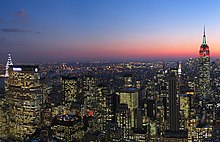
In the United States, an incorporated area or group of areas having a population more than 50,000 is required to have a metropolitan planning organization in order to facilitate major infrastructure projects and to ensure financial solvency. Thus, a population of 50,000 or greater has been used as a de facto standard to define a metropolis in the United States. A similar definition is used by the United States Census Bureau. The bureau defines a Metropolitan Statistical Area as "at least one urbanized area of 50,000 or more inhabitants." The six largest metropolitan areas in the USA are New York, Los Angeles, Chicago, Dallas, Houston, and Washington, D.C., with New York being the largest.
Oceania
[edit]Australia
[edit]The Australian Bureau of Statistics defines a metropolitan area as any statistical division or district with a population of more than 100,000.[53] According to this definition, there are currently 19 metropolitan areas in Australia, including every state capital. By population, the largest metropolitan area is Sydney (urban area population at 2020 Census of 5,367,206) and the smallest is Bendigo (urban area population at 2020 Census of 100,632). Rapid urban growth in Victoria has seen the 'Manhattanization' of Melbourne, with high-rise clusters in South Yarra, Box Hill, Moonee Ponds and Footscray. The regional city of Geelong which is approximately 40 miles south west of Melbourne, has seen the emergence of high-rise office and apartment buildings in recent years. Geelong is the fastest growing regional city in Australia, and its growth will transform the Port Phillip region in a similar manner to San Francisco's Bay Area. (urban area population at 2020 Census of 160,991).[54]
-
Sydney is Australia's largest metropolis.
-
Melbourne is Australia's second-largest metropolis.
-
Brisbane is Australia's third-largest metropolis.
-
Perth is the largest city in Western Australia.
-
Adelaide is the largest city in South Australia.
South America
[edit]Argentina
[edit]
In Argentina, Buenos Aires is the principal metropolis with a population of around 15.5 million.[55] The Greater Buenos Aires conurbation, which also includes several Buenos Aires Province districts, constitutes the third-largest conurbation in Latin America.[56] Buenos Aires is the main political, financial, industrial, commercial, and cultural hub of Argentina.
Brazil
[edit]
In Brazil, the Greater São Paulo is the principal metropolis with over 21 million inhabitants. In the larger cities, such as São Paulo and Rio de Janeiro (population 12 million), favelas (slums) grew up over decades as people migrated from rural areas in order to find work. The term used in Brazilian Portuguese for a metropolitan area is Região Metropolitana. Other metropolises in Brazil with more than one million inhabitants include: Belém, Belo Horizonte, Brasília, Campinas, Curitiba, Fortaleza, Goiânia, Maceió, Manaus, Porto Alegre, Recife, Salvador and São Luís.
Chile
[edit]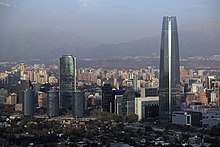
The primary metropolis in Chile is its capital: the city of Santiago, with a population of seven million, living across its metropolitan area. Santiago is the main political, financial, industrial, commercial, and cultural hub of Chile. The other two metropolises in the country are the conurbations of Valparaíso and Concepción with a population of nearly one million each.
Colombia
[edit]In Colombia, Bogotá is the main metropolis with over 13 million inhabitants residing in its Metropolitan Area, which includes boroughs like Soacha, Mosquera, Cota, and Chía. The second metropolis in Colombia is Medellín, which includes such boroughs as Envigado, Itagüi, La Estrella, and Sabaneta. This metropolitan area is known for having the first and only Metro in Colombia, the Medellín Metro. Bogotá has the Transmilenio, a Rapid Transit Metro-bus system.
Peru
[edit]The Lima metropolitan area is Peru's capital and largest city with over 10 million inhabitants, more than one third of the total national population.
Metropolis as a mainland area
[edit]In France, Portugal, Spain, and the Netherlands, the word metropolis (métropole (Fr.) / metrópole (Port.) / metrópoli (Spa.) / metropool (Dutch)) designates the mainland part of a country situated on or close to the European mainland; in the case of France, this means France without its overseas departments. For Portugal and Spain during the Spanish Empire and Portuguese Empire period, the term was used to designate Portugal or Spain minus its colonies (the Ultramar). In France métropole can also be used to refer to a large urban agglomeration; for example, "La Métropole de Lyon" (the Lyon Metropolis).
See also
[edit]References
[edit]- ^ Keri Blakinger (March 8, 2016). "From Gotham to Metropolis: A look at NYC's best nicknames". Daily News. New York. Archived from the original on November 5, 2022. Retrieved August 6, 2017.
- ^ "Definition of Metropolis". Oxford Dictionaries. Archived from the original on March 7, 2016. Retrieved March 2, 2016.
- ^ "Definition of metropolis". Collins English Dictionary. Archived from the original on February 3, 2013. Retrieved October 23, 2012.
- ^ Iris Reuther (FG Stadt- und Regionalplanung, Universität Kassel): Presentation "Regiopole Rostock". December 11, 2008. Retrieved June 13, 2009 (pdf).
- ^ Louis Boisgibault, Fahad Al Kabbani (2020): Energy Transition in Metropolises, Rural Areas and Deserts Archived January 21, 2020, at the Wayback Machine. Wiley - ISTE. (Energy series) ISBN 9781786304995.
- ^ "metropolis, n." OED Online, Oxford University Press, June 2017, www.oed.com/view/Entry/117704. Retrieved December 19, 2017; "polis, n.2." OED Online, Oxford University Press, June 2017, www.oed.com/view/Entry/146859. Retrieved December 19, 2017.
- ^ "Definition of METROPOLIS". Merriam-Webster. August 1, 2023. Archived from the original on November 7, 2021. Retrieved November 7, 2021.
- ^ "City Population Reporting on Instituto Nacional de Estatística, República de Angola (web) Projection July 2019". Archived from the original on February 12, 2018. Retrieved February 12, 2018.
- ^ a b c Institut National De La Statistique L’Institut national de la statistique et des études économiques. "Projections demographiques 2019–25 (in French)". Archived from the original on July 2, 2020. Retrieved September 23, 2020.
- ^ Harrington, Rebecca. "These will be the world's 10 biggest cities in 2050 — and you probably haven't heard of some of them". Business Insider. Archived from the original on February 19, 2016. Retrieved February 18, 2016.
- ^ "2011 National Statistics". Csa.gov.et. Archived from the original on March 30, 2013. Retrieved July 20, 2013.
- ^ "Environmental and Structural Inequalities in Greater Accra". The Journal of the International Institute. Archived from the original on October 19, 2012. Retrieved July 22, 2010.
- ^ "Abidjan, Ivory Coast Population (2023) - Population Stat". populationstat.com. Archived from the original on January 19, 2021. Retrieved January 24, 2021.
- ^ "2019 Kenya Population and Housing Census Volume I: Population by County and Sub-County". knbs.or.ke. Archived from the original on November 13, 2019. Retrieved November 7, 2019.
- ^ "Population". Lagos State Government. 2011. Archived from the original on October 18, 2015. Retrieved November 3, 2012.
- ^ Pacetti, M.; Passerini, G.; Brebbia, C.A.; Latini, G. (2012). The Sustainable City VII: Urban Regeneration and Sustainability. WIT Press. ISBN 9781845645786.
- ^ "City Mayors: World's fastest growing urban areas (1)". Archived from the original on November 25, 2010. Retrieved May 25, 2015.
- ^ Hoornweg, Daniel; Pope, Kevin. "Socioeconomic Pathways and Regional Distribution of the World's 101 Largest Cities" (PDF). media.wix.com. Archived (PDF) from the original on July 25, 2018. Retrieved January 24, 2021.
- ^ City of Cape Town (December 2020). State of Cape Town Report 2020 (PDF) (Report). Archived (PDF) from the original on August 12, 2022. Retrieved July 5, 2023.
- ^ "Ethekwini, South Africa Metro Area Population 1950-2023". www.macrotrends.net. Archived from the original on July 5, 2023. Retrieved July 5, 2023.
- ^ https://www.ubos.org/wp-content/uploads/publication/09_2019Final_2020_21_LLG_IPFs_Sept_2019.pdf[permanent dead link]
- ^ "City Mayors: World's fastest-growing urban areas (1)". www.citymayors.com. Archived from the original on November 25, 2010. Retrieved January 24, 2021.
- ^ Szoldra, Paul. "Unbelievable Photos Show Kabul's Dramatic Transformation From Battlefield To Modern Metropolis". Business Insider. Archived from the original on November 13, 2020. Retrieved November 6, 2020.
- ^ "60% of Bangladesh urban population in metropolitan cities". Archived from the original on March 20, 2022. Retrieved March 14, 2022.
- ^ "South Asia – World Population Day – July 11(South Asia Urban Growth)". World Bank. Archived from the original on July 2, 2018. Retrieved October 29, 2012.
- ^ "Provisional Population Totals Urban Agglomerations and Cities" (PDF). Census of India 2011. Archived (PDF) from the original on April 3, 2016. Retrieved January 30, 2016.
- ^ "Local Government in Japan" (PDF). Council of Local Authorities for International Relations. p. 41. Archived from the original (PDF) on October 25, 2007. Retrieved October 16, 2007.
- ^ "Biggest Cities In Malaysia". WorldAtlas. January 11, 2018. Archived from the original on February 18, 2022. Retrieved February 18, 2022.
- ^ "Population Size and Growth of Major Cities" (PDF). Demographia.com. Archived (PDF) from the original on February 7, 2020. Retrieved March 13, 2020.
- ^ "6th census of Pakistan will be held in March 2016". Siasat.pk Forums. Archived from the original on February 21, 2018. Retrieved March 13, 2020.
- ^ "March 2017 as the month of Census in Pakistan". December 16, 2016. Archived from the original on June 30, 2020. Retrieved March 13, 2020.
- ^ "District wise census results census 2017" (PDF). www.pbscensus.gov.pk. Archived from the original (PDF) on August 29, 2017. Retrieved September 3, 2017.
- ^ "Philippine Development Plan 2017–2022, Chapter 3: An overlay of economic growth, demographic trends and physical characteristics" (PDF). National Economic and Development Authority. 2017. Archived (PDF) from the original on July 25, 2020. Retrieved April 21, 2018.
- ^ Kumarage A, Amal (November 1, 2007). "Impacts of Transportation Infrastructure and Services on Urban Poverty and Land Development in Colombo, Sri Lanka" (PDF). Global Urban Development Volume 3 Issue 1. Archived (PDF) from the original on March 4, 2016. Retrieved August 24, 2018.
- ^ "The 10 Traits of Globally Fluent Metro Areas" (PDF). 2013. Brookings Institution. Archived from the original (PDF) on April 2, 2015. Retrieved August 24, 2018.
- ^ "Colombo: The Heartbeat of Sri Lanka/ Metro Colombo Urban Development Project". The World Bank. March 21, 2013. Archived from the original on April 12, 2015. Retrieved August 24, 2018.
- ^ "Turning Sri Lanka's Urban Vision into Policy and Action" (PDF). 2012. UN Habitat, Chapter 1, Page 7. Archived from the original (PDF) on March 4, 2016. Retrieved August 24, 2018.
- ^ 鄉鎮市區人口及按都會區統計. Taiwan Ministry of Interior. 2013. Archived from the original on March 29, 2014. Retrieved November 25, 2018.
- ^ "高雄市政府主計處全球資訊網 – 首頁". dbaskmg.kcg.gov.tw (in Chinese). Archived from the original on May 11, 2016. Retrieved June 6, 2016.
- ^ "United Arab Emirates: metropolitan areas". World-gazetteer.com. Archived from the original on October 1, 2007. Retrieved July 31, 2009.
- ^ ""Prostorni plan Kantona Sarajevo za period od 2003. do 2023. godine"" (PDF). Archived from the original (PDF) on September 6, 2018.
- ^ "Database – Eurostat". European Commission. Archived from the original on December 25, 2018. Retrieved December 4, 2018.
- ^ "Statistikbanken". statistikbanken.dk. Archived from the original on June 23, 2017. Retrieved December 4, 2018.
- ^ Brutel, Chantal (January 18, 2011). "Un maillage du territoire français" [A network of French territory] (in French). Institut national de la statistique et des études économiques. Archived from the original on April 24, 2017. Retrieved October 4, 2017.
- ^ "Initiativkreise Europäische Metropolregion in Deutschland: IKM". Deutsche-metropolregionen.org. Archived from the original on May 17, 2020. Retrieved October 29, 2012.
- ^ "How Italy puts cities in charge". August 2, 2023. Archived from the original on February 3, 2017. Retrieved December 16, 2014.
- ^ "RUSSIA: Central'nyj Federal'nyj Okrug – Central Federal District". City Population.de. August 8, 2020. Archived from the original on October 25, 2021. Retrieved September 1, 2020.
- ^ a b "Demographia World Urban Areas" (PDF). Demographia. Archived (PDF) from the original on February 7, 2020. Retrieved July 22, 2020.
- ^ a b Akishin, Alexander (August 17, 2017). "A 3-Hour Commute: A Close Look At Moscow The Megapolis". Strelka Mag. Archived from the original on April 17, 2021. Retrieved May 23, 2020.
- ^ "Moscow, a City Undergoing Transformation". Planète Énergies. September 11, 2017. Archived from the original on October 27, 2021. Retrieved May 27, 2020.
- ^ "RUSSIA: Severo-Zapadnyj Federal'nyj Okrug: Northwestern Federal District". City Population.de. August 8, 2020. Archived from the original on October 25, 2021. Retrieved October 24, 2020.
- ^ "census metropolitan area (cma) and census agglomeration (ca), 2001 census". 2.statcan.ca. Archived from the original on September 30, 2020. Retrieved October 29, 2012.
- ^ "1217.0.55.001 – Glossary of Statistical Geography Terminology, 2003". Australian Bureau of Statistics. October 29, 2013. Archived from the original on March 10, 2020. Retrieved June 24, 2012.
- ^ Statistics, c=AU; o=Commonwealth of Australia; ou=Australian Bureau of. "Media Release – Ten years of growth: Australia's population hotspots (Media Release)". abs.gov.au. Archived from the original on September 30, 2017. Retrieved January 20, 2018.
{{cite web}}: CS1 maint: multiple names: authors list (link) - ^ "Censo 2010. Resultados provisionales: cuadros y gráficos" (in Spanish). Archived from the original on December 20, 2010. Retrieved February 25, 2011.
- ^ "About Buenos Aires". EnjoyBA. Archived from the original on November 1, 2019. Retrieved August 17, 2015.
Further reading
[edit]- Census.gov, U.S. Census Bureau, About Metropolitan and Micropolitan Statistics
- MetroForum.com, forum dedicated to discussions on metropolis
- Blog.ar2com.de, a podcast with a worldwide analysis of megacities (focus Latin America)
- E-geopolis.eu at the Library of Congress Web Archives (archived October 27, 2009): research group, university of Paris-Diderot, France
- See Ronald Daus´s bibliography, researcher at the Free University of Berlin







